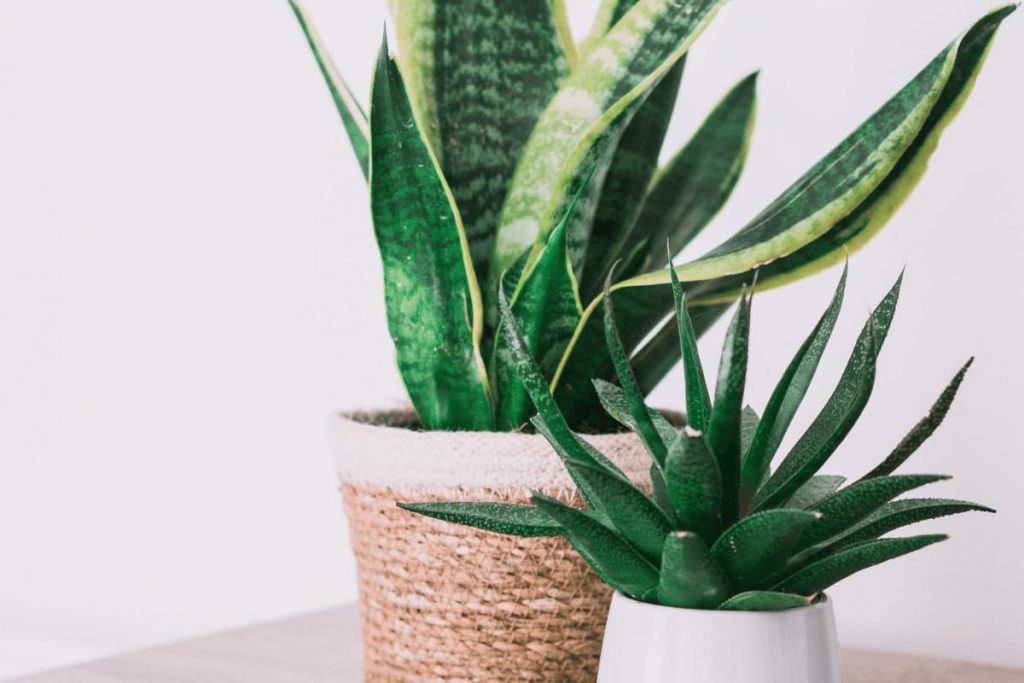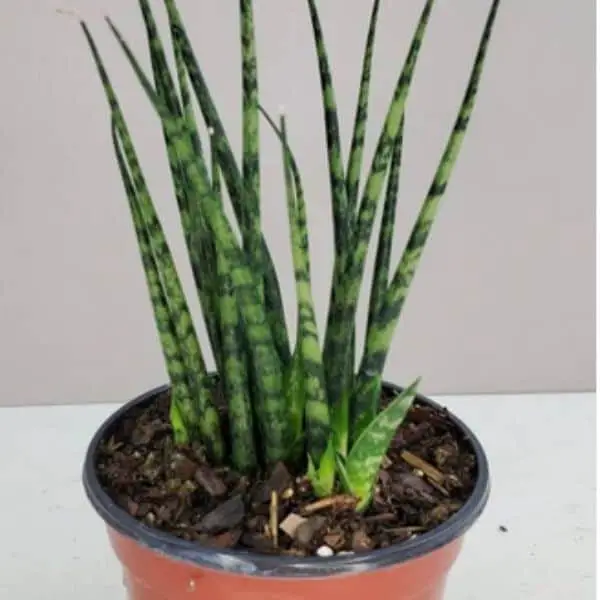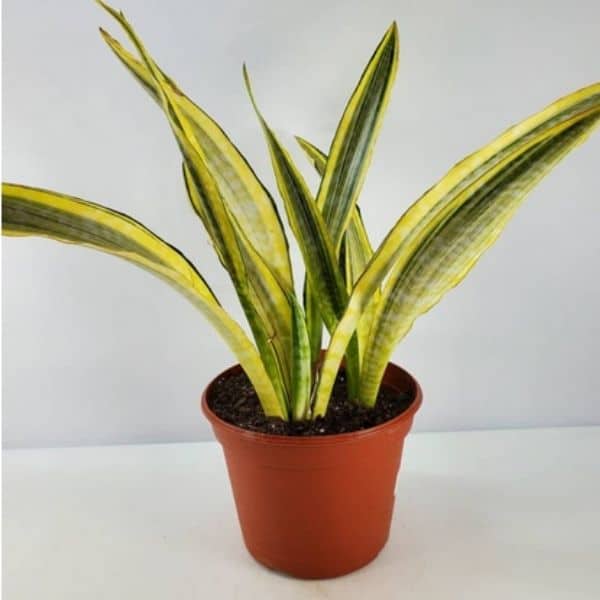Last Updated on July 26, 2022 by Plantiful Interiors
How To Care For Snake Plant Indoors + Everything You Need To Know
Snake plants are easy to care for and grow quickly. They’re perfect for beginners looking to add some greenery to their homes. In this ultimate snake plant care guide you’ll learn how to care for snake plant indoors properly!
If you’re looking for a low maintenance plant, snake plant is an excellent pick.
The snake plant is one of the most common tropical houseplants thanks to it’s easy to care for nature. They can go weeks without being watered. In fact, the most common cause of death for snake plants is due to overwatering.
This post contains affiliate links. As an affiliate partner of various brands, we earn a little commission on qualifying purchases, at no extra cost to you. When you purchase through our links, you help our business to keep going. So thank you for your support! You may read our full disclaimer for more information.
Snake plants thrive in pretty much all light conditions and are tolerant of low light areas making them excellent for rooms with west facing windows.
The following snake plant care guide will tell you everything you need to know to keep your snake plant alive, healthy and living for many years.
At A Glance: How To Care For Snake Plant
Not only is the snake plant an excellent choice for beginner plant hobbyists and those who don’t have a green thumb, they are a good air purifying plant as well.
Depending on the type you purchase (see Snake Plant varieties below), these slower growing plants can grow anywhere between 4 inches all the way up to 6 feet tall and do best planted in well-draining pots.
Snake Plant Pros
We’ll cover each of these snake plant benefits in more detail below.
But first, to really know how to best care for a snake plant, you should learn a little more about the plant itself.
Other Names For The Snake Plant
You may hear the snake plant referred to as mother-in-laws tongue or by its Botanical name sansevieria. We’ll be using these names interchangeably throughout the article.
Common Snake Plant Names:
- Snake Plant
- Mother-In-Law’s Tongue
- Viper’s Bowstring Hemp
- Sansevieria Trifasciata (Botanical Name)
Hearing this plant referred to as mother-in-law’s tongue peeked my interest.
I couldn’t help but wonder, why is a snake plant is called a mother-in-law’s tongue?
After a little digging around on the internet, the consensus seems to be that the sharp pointed leaves resemble the tone of a mother-in-law.
If your mother-in-law has ever heard this, this plant probably isn’t one you want to gift her as that could get awkward.
Keep reading for more tips on how to care for Snake Plant / Sansevieria
Snake Plant Origin
Snake plants are native to western Africa and were commonly used for making bowstrings out of the plant’s fibers. The leaves from a snake plant were also used in traditional first aid as bandages as the sansevieria was known to produce a sap with antiseptic properties.
In North America the snake plant is a common indoor plant used for ornamental purposes, decorating homes and offices across the Country.
But in Australia this plant, most commonly referred to as mother in laws tongue, grows wildly outdoors and is often referred to as a weed.
The Ultimate Guide: How To Care For Snake Plant
How Much Light Do Snake Plants Need?
Snake plants thrive in many lighting conditions which is why they top the list of easy to care for indoor plants. Snake plants will grow faster in bright areas and slower in low light areas.
Although they can withstand direct sunlight, it is recommended you display your sansevieria in indirect sunlight so that you don’t risk burning the leaves.
Place your snake plant 8-10 feet away from an west facing window for optimal lighting conditions.
Be sure that the room is not susceptible to drafts and temperature does not fall below 40 °F.
When To Water A Snake Plant
Knowing how to care for snake plant is fairly straightforward, but if you want your houseplant to remain healthy and in pristine condition, there are certain snake plant care guidelines you need to follow like when to water and how much.
The two biggest enemies of this plant are freezing temperatures and too much water. The former shouldn’t be a problem if our plant is indoors.
Overwatering leads to root rot which is the most common reason snake plants die.
You should aim to keep the soil of your snake plant moist but never soggy. However, it will tolerate dry soil for a short period of time if you happen to forget to water your snake plant.
Watering every two weeks is usually a good schedule but you should check the soil with your finger or a moisture meter in between just to be sure it’s not drying out too quickly.
Get your fingers dirty by poking them into the soil and if there’s any moisture in there, then hold back on the watering for now.
Always make sure the soil is pretty much dried out before adding any water.
Make sure to plant your snake plant in a pot with drain holes so any excess water can drain out. Wipe up any water from the drain tray so your snake plant is not sitting in standing water.
You can reduce the amount of water in the winter, as snake plants do not actively grow during this season.
How to Water Snake Plant
When it’s time to water your snake plant, if possible water from the bottom.
- Place your pot in a container or sink large enough to hold the pot
- Fill the container or sink with enough water to cover the bottom 1-2 inches of the pot
- Let the plant soak for 10 minutes then check the top few inches of soil with your finger. If the soil is still dry, leave for another 10 minutes then remove the pot
- Do not soak for any more than 20 minutes
- Place the snake plant back in its regular location
- use a drip tray to catch any excess water but be sure to wipe it dry so the plant does not continue to sit in water
What Type of Soil Is Best For Snake Plant?
Remember, snake plants don’t like soggy soil and root rot from overwatering is the most common cause of death for these plants.
You will need a fast, well-draining soil.
Plant your snake plant in a quality succulent and cacti mix with a bit of added pumice or perlite to better the drainage and aeration.
Look for a well draining potting mix that contains:
We typically go for a cacti and succulent mix as this type of soil is typically very well-draining. Then, we add our own perlite to the mixture to create more aeration around the roots.
If you prefer, you can make your own DIY cacti and succulent soil mix.
How To Propagate a Snake Plant
Instead of paying money for additional plants, you can breed your own through propagation.
There are three different methods you can use to propagate your snake plant
- Soil
- Water
- Divide offsets
Propagation by water and soil involves using cuttings from your plant. Using the division method typically involves removing the plant from its existing pot and cutting it apart at the root base.
There is no one method that works better than the others, it’s a personal choice for which propagation method you use.
Propagating your snake plant can happen at any time but Spring is the most advisable. This is because new growth with happen faster during the summer months when the plant is in its natural growth cycle.
How To Propagate Snake Plant (Sansevieria) In Soil
What you’ll need:
- Gardening scissors
- Well-draining soil
- Seedling tray or grower’s pot
Step 1: Using a pair of stainless steel scissors, cut one of your snake plants leaves at the base
Step 2: Cut the leaf into 3 to 4 sections
- Keep note of which end is the bottom as you will need to plant these the same way, otherwise they will not root, meaning they will not grow.
Step 3: Allow the cuttings to callous over as this usually takes 2 days
Step 4: Place the cuttings in a well-draining soil mix
- If you have less than 5 cuttings you may choose to start them all in the same pot
- If you have more than 5 cuttings considering using a seedling starter tray as using a seedling tray will make it easier down the road when it comes time to move them to a larger pot.
- The more cuttings you have the more likely you are to have success
Step 5: Keep the soil slightly moist while it is rooting
Step 6: Once roots are established you can lessen the amount of watering
Step 7: Have patience. It will take about 3 months to start seeing new growth.
- Take note that the cutting itself will not grow, instead you will see new leaves appear. Once a new leaf is formed you can cut down the original cutting
How To Propagate Snake Plant (Sansevieria) In Water
This is one of the most interesting ways to propagate your snake plant because you get to actually watch the roots grow.
What you’ll need:
- Gardening scissors
- Glass vase
- Water
Step 1: Cut one of your snake plants leaves at the base
- You can stop here and skip to step 3 if you want to grow from the entire leaf or proceed to step 2
Step 2: Cut the leaf into 3 to 4 sections
- Keep note of which end is the bottom as you will need to plant these the same way, otherwise they will not root, meaning they will not grow. This will give you more plants than if you leave the leaf whole
Step 3: Allow the cutting(s) to callous over as this usually takes 2 days
Step 4: Place your cutting(s) in a vase (bottoms down) so that the bottom quarter of the cutting is submerged
- Your cutting(s) must be able to stand up as use a skinny vase of some type of support
Step 5: Place the vase in an area where it will get indirect sunlight
Step 6: Change the water once per week
Step 7: Wait – similar to propagating in soil, it can take a month or two before you start seeing roots, then another month or two after that when you start to see new leaf growth
Step 8: Once the roots are about one to two inches in length, it’s time to pot your plant in a well-draining soil mix and wait for new leaves to start popping up.
How To Propagate Snake Plant (Sansevieria) By Dividing Offsets
What you’ll need:
- Garden knife – this is our top pick
- Gardening gloves
- Growers pot
- Well-draining soil
Step 1: Remove your snake plant from its pot
Step 2: Gently knock off all of the soil until the roots are bare
Step 3: Use your garden knife to cut the rhizome
Step 4: Plant each of your offsets into its own grower’s pot
Step 5: Water your new potting
Step 6: Place in an area with indirect sunlight
Step 7: Watch for new growth. Because the sansevieria roots are already established the amount of time to see new growth will be less than using water or soil propagation methods.
This method is sometimes easier to understand when you can see the process happening. Check out the video below to know how to divide your offsets and where you should be cutting.
How Fast Do Snake Plants Grow?
Patience is the key as the snake plant isn’t known for its rapid growth.
The above propagation methods can take a while before any noticeable results are forthcoming.
You can expect to wait two months or even longer before any roots begin to sprout on your new snake plant when growing directly in water.
By planting directly into the soil, you’re likely to start seeing your new sansevieria plants growing roots in about a month, with new growth appearing a month later.
Depending on the variety of snake plant you have, an established plant can grow anywhere between 4 inches, up to 6 feet tall.
As mentioned earlier, the sansevieria will grow faster in moderate to bright light conditions and slower in low light conditions.
The growth cycle of the snake plant occurs during the summer months and is not actively growing during winter months. This makes spring the best time to propagate a snake plant so new growth can occur during the summer months.
Are Snake Plants Safe For Cats And Dogs?
No, the snake plant is not safe for pets. The snake plant is toxic to cats and dogs.
Snake plants contain what’s known as saponins. This natural chemical is a defense mechanism that the plant uses to protect itself against insects, microbes, and fungi. Great for the snake plant but no so good for animals, especially cats and dogs.
Although only mildly toxic to pets, it can cause gastrointestinal upset in animals if it’s ingested, resulting in diarrhea, nausea, and vomiting.
If you have pets, before bringing any new plant home you should check to see if it could be harmful to your pet. The ASPCA has a list you can reference to find out if a plant is toxic or nontoxic to cats and dogs.
It is also advisable to keep this plant out of reach from small children.
Air Purifying Benefits of Snake Plant
Not only do they look great and will definitely catch your eye with their striking rigid sword-like green leaves with yellow and white blooms, but snake plants do a great deal more than just sit in a pot looking pretty.
Snake plant is one of the best indoor plants for purifying the air.
This evergreen house plant is accomplished at removing toxins from the air, such as formaldehyde, xylene, and nitrogen oxides.
There are many oxygen releasing plants, but the snake plant is unique as it converts a lot of carbon dioxide into oxygen during the night, making them a great plant for your bedroom.
It gets better.
Because these clever houseplants absorb toxins and release oxygen, and lessen airborne allergies by releasing moisture into the air. So next time your asthma suffering friend’s birthday comes along, maybe instead of that book she asked for, it might be a good idea to surprise her with a snake plant instead.
For a better explanation of how plants, such as the snake plant, remove indoor carcinogens watch this video.
Snake Plant Varieties
Some of the most common sansevieria varieties include:
For a more comprehensive list with pictures that will help you identify which type of snake plant you own, check out this article from Urban Organic Field.
What To Look For When Buying Snake Plant
By now you know how to care for a snake plant but if you don’t yet have a snake plant yet, it’s good to educate yourself on what to look for when buying a snake plant so you know how to pick a healthy sansevieria.
The leaves of the snake plant should be plump and fresh looking with no brown spots.
Snake plant leaves should be rigid, not floppy.
Leaves should be vibrant in color (typically dark green, depending on the type).
Wrinkles in the leaves are a sign of root rot meaning this plant has been overwatered and likely won’t survive.
Look to see if there is new growth coming up through the soil as this is a definite sign of a healthy, growing mother-in-law’s tongue.
Check the soil, it should feel moist or dry but not saturated.
How To Care For Snake Plant – FAQs
Is Sanseveieria a succulent?
Yes, sansevieria is a succulent.
How do I know if my snake plant is healthy?
The leaves of your snake plant should be rigid and vibrant. If there are signs of yellowing, wrinkles or floppiness this may be an indication that your plant is unhealthy.
Should I water my snake plant from the top or bottom?
Where possible, water your snake plant from the bottom. This will help strengthen the roots and encourage them to grow downwards as they reach for moisture.
What size of pot should I plant my Snake Plant in?
Snake plants do best in small to medium size pots and prefer to be pot bound. Depending on the size of your plant you’ll likely need a pot between 4 to 10 inches.
Do snake plants need drain holes?
Yes. To help prevent overwatering your snake plant should be planted in a pot with drain holes.
Wrapping Up How To Care For Snake Plant Indoors
The snake plant is a striking plant that will bring any room in the house to life.
If that’s not enough, then just remember, as you’re sound asleep during the night, this ingenious piece of horticultural magnificence is hard at work converting carbon dioxide into oxygen as well as releasing moisture into the air to give some relief to those allergy sufferers among us.
Now you know how to care for your snake plant, what to look for when buying a snake plant and the air purifying benefits of the snake plant.
There’s no reason (even if you claim not to have a greeen thumb) to avoid this houseplant. With the snake plant being one of the easiest indoor plants to grow, you’re ready to grow your own healthy and vibrant sansevieria.
You May Also Enjoy These Plant Care Articles
Must Have Indoor Plant Care Tools To Keep House Plants Alive
How To Root Plant Cuttings In Water (6 easy steps)
7 Indoor Plants That Bring Good Luck To Your Home











